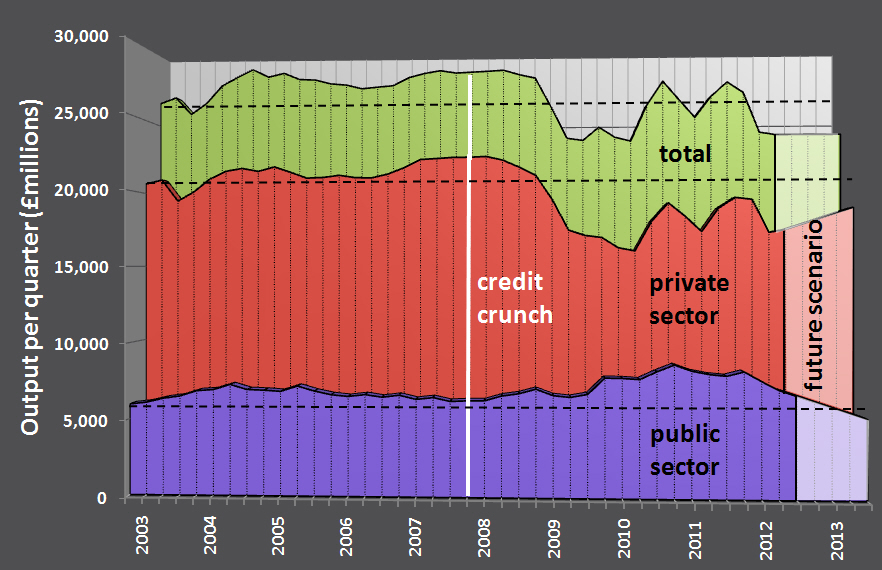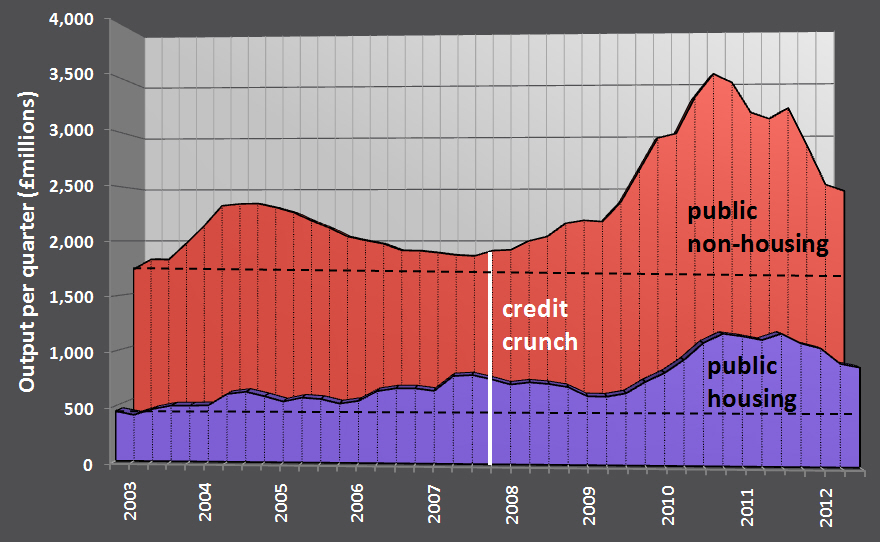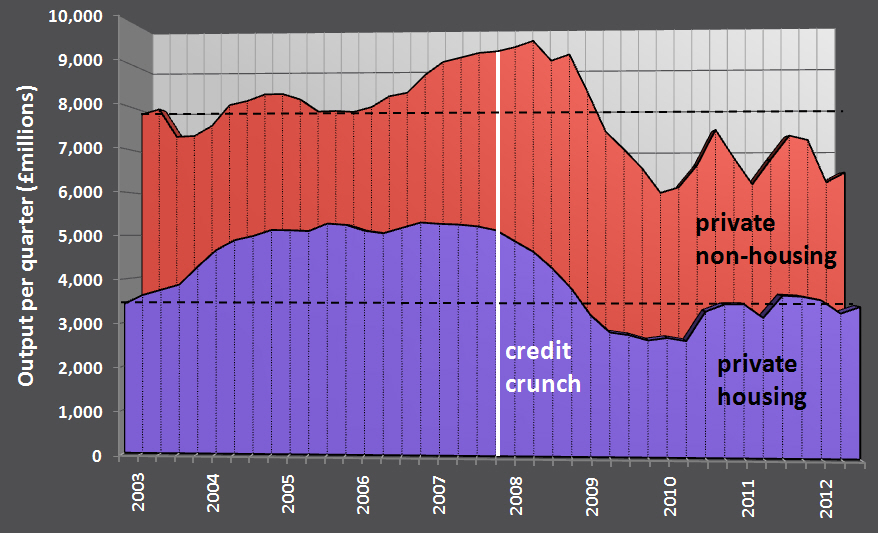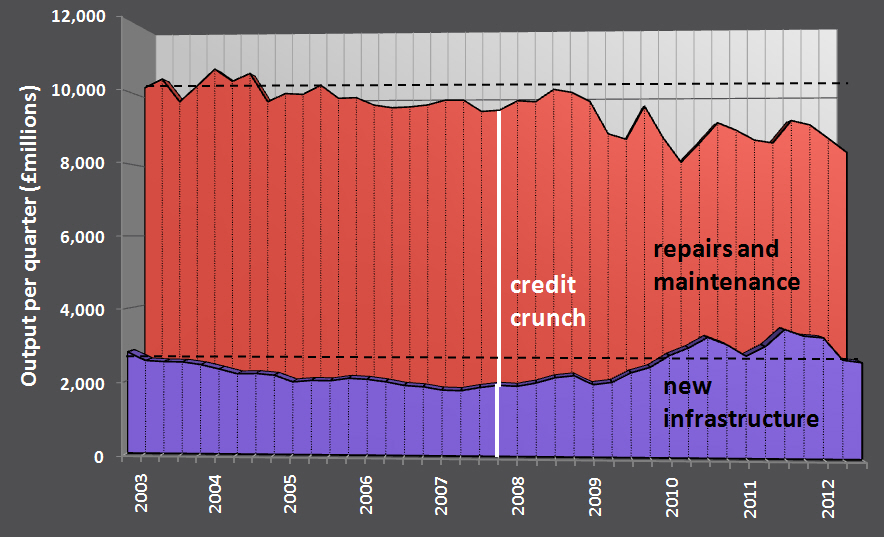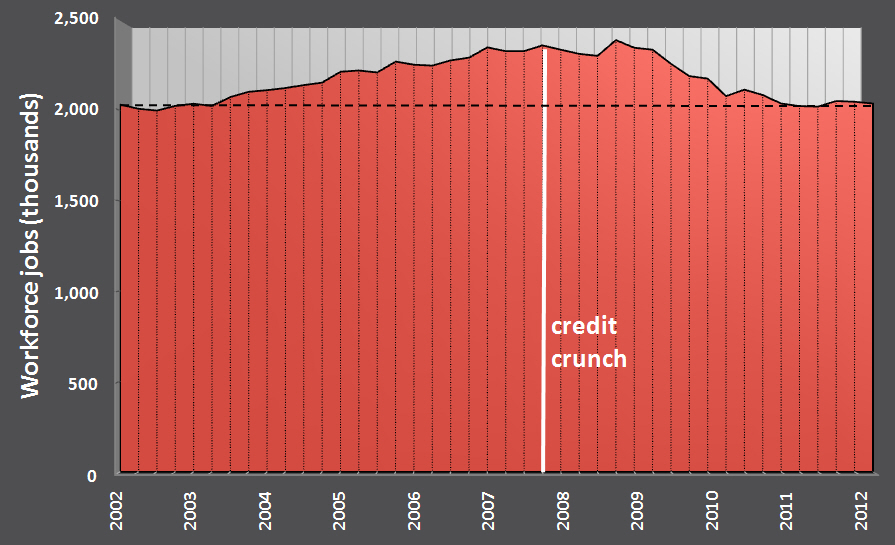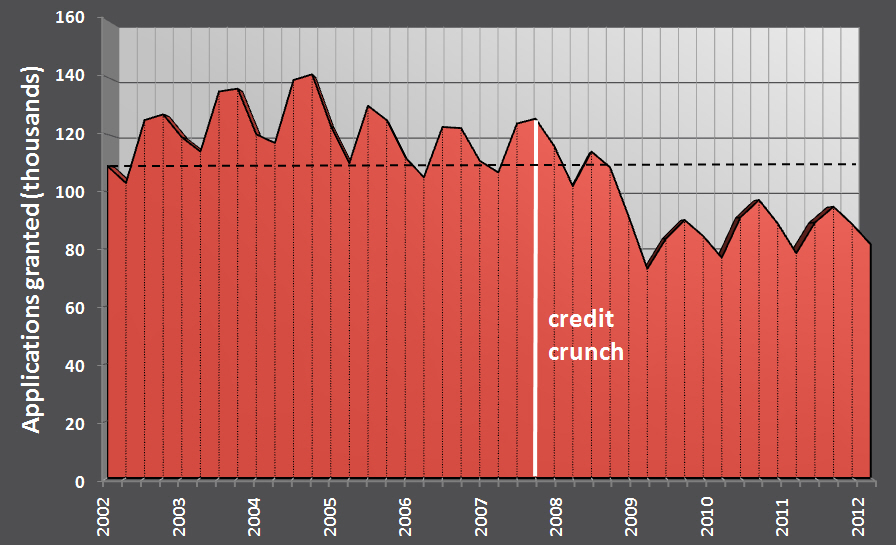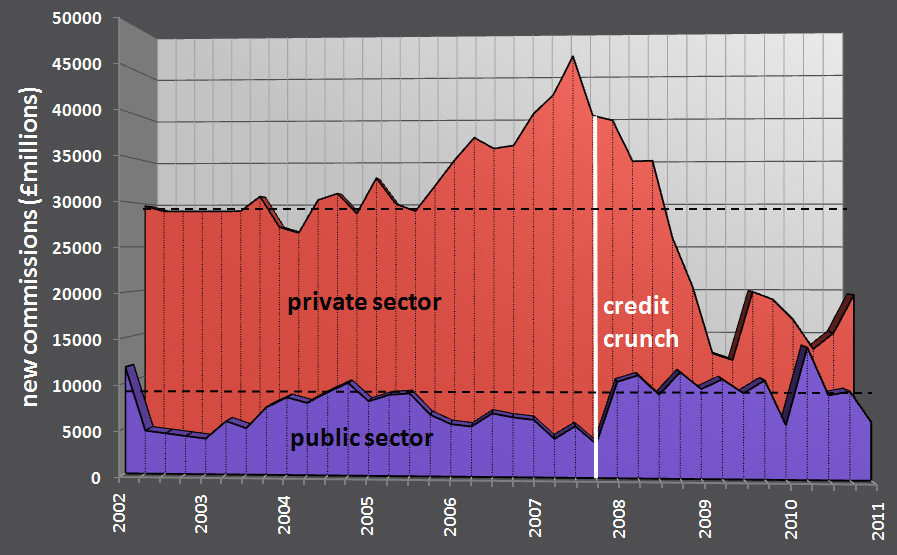The state of UK construction August 2012
CONSTRUCTION SLUMP - PERFECT STORM
Click here to download a full pdf version of this report with comments and proposed strategies for recovery from Designing Buildings Wiki. File:The state of UK construction - Designing Buildings Wiki.pdf.
Total construction industry output still 9% down on what it was 10 years ago.
The private sector will need to grow by a third of a billion a quarter to maintain output levels if public sector cuts.
Contents |
Total output
- Public sector output has increased by 12% in the last 10 years, whilst private sector output has shrunk by 15%.
- This increase in public sector spending, in combination with the beginnings of a recovery in the private sector during 2010 / 2011, meant that by the second half of 2011, total output for UK construction peaked at nearly 5% higher than it had been in 2002.
- However, in the first half of 2012, both public and private sector output fell, resulting in total output dropping to a level 9% lower than it was in 2002.
- If the public sector continues to shrink at this rate, the private sector will have to grow by more than a third of a billion pounds a quarter just to keep total output at its current level (see the future scenario illustrated on the adjacent graph).
- If the public sector continues to shrink, and the private sector does not grow to fill the void, the industry will enter a double dip recession.
Volume of construction output. Non- seasonally adjusted output/quarter in Great Britain (£millions at 2005 prices)
Public sector new build
- The post credit crunch rise in new public sector projects was dramatic, as has been its recent decline. Between the beginning of 2008 and the peak in 2010, public sector housing grew by 60% and public sector non-housing by an extraordinary 78%.
- Since that peak, public sector housing has shrunk back by 25% and public sector non-housing by 31%.
Public sector housing and non-housing. Output/quarter (£millions 2005 prices) in Great Britain
Private sector new build
- Private sector housing and non-housing collapsed with the loss of confidence and withdrawal of finance following the credit crunch. At their lowest, private sector housing was 50% below its peak, and private sector non-housing was 38% below its peak. They have subsequently been experiencing a patchy and slow recovery, but are still well below their peak.
Private sector housing and non-housing. Output/quarter (£millions 2005 prices) in Great Britain
Infrastructure repairs and maintenance
- Repairs and maintenance have progressively declined since 2004, falling to 19% below their 2002 level. In contrast, new infrastructure projects peaked at 27% higher than their 2002 level. Since the middle of 2011 however, infrastructure projects have fallen back.
Infrastructure, repairs and maintenance. Output/quarter (£millions 2005 prices) in Great Britain
Workforce
- Despite dramatic and rapid changes in the make up and size of the industry, employment has remained relatively stable, 15% lower than its peak, but roughly level with its position in 2002.
Workforce jobs. Seasonally adjusted (thousands) in the UK
- Construction is generally preceded by a successful planning application, and so the number of applications granted can be a useful indicator of the outlook for construction.
- Whilst there are some slight signs of a recovery from the lowest period in 2009, permissions remain 30% lower than they were in the same period in 2004, suggesting that the outlook is poor.
Planning applications granted. Thousands in England
Architect's commissions
- Planning applications are generally preceded by architectural design. Public sector architectural commissions held up relatively well until the second half of 2010. However, private sector commissions collapsed by 74% between their peak in 2007 and the beginning of 2009 and were showing little sign of recovery by the end of 2010.
- Regrettably, this data set has been discontinued by the Office for National Statistics. However a number of deductions can be made from the RIBA future trends survey. This survey indicates that whilst there was some optimism at the beginning of 2012, by July of this year, architects were predicting that their workload would remain constant or decrease across all sectors in the next 3 months. This suggests that the outlook for construction is poor.
Architects’ workload. Estimated value of new commissions (£millions at 2005 prices) in the UK
Sources of information
Featured articles and news
One of the most impressive Victorian architects. Book review.
Common Assessment Standard now with building safety
New CAS update now includes building safety questions as mandatory.
RTPI leader to become new CIOB Chief Executive Officer
Dr Victoria Hills MRTPI, FICE to take over after Caroline Gumble’s departure.
Social and affordable housing, a long term plan for delivery
The “Delivering a Decade of Renewal for Social and Affordable Housing” strategy sets out future path.
A change to adoptive architecture
Effects of global weather warming on architectural detailing, material choice and human interaction.
The proposed publicly owned and backed subsidiary of Homes England, to facilitate new homes.
How big is the problem and what can we do to mitigate the effects?
Overheating guidance and tools for building designers
A number of cool guides to help with the heat.
The UK's Modern Industrial Strategy: A 10 year plan
Previous consultation criticism, current key elements and general support with some persisting reservations.
Building Safety Regulator reforms
New roles, new staff and a new fast track service pave the way for a single construction regulator.
Architectural Technologist CPDs and Communications
CIAT CPD… and how you can do it!
Cooling centres and cool spaces
Managing extreme heat in cities by directing the public to places for heat stress relief and water sources.
Winter gardens: A brief history and warm variations
Extending the season with glass in different forms and terms.
Restoring Great Yarmouth's Winter Gardens
Transforming one of the least sustainable constructions imaginable.
Construction Skills Mission Board launch sector drive
Newly formed government and industry collaboration set strategy for recruiting an additional 100,000 construction workers a year.
New Architects Code comes into effect in September 2025
ARB Architects Code of Conduct and Practice available with ongoing consultation regarding guidance.
Welsh Skills Body (Medr) launches ambitious plan
The new skills body brings together funding and regulation of tertiary education and research for the devolved nation.
Paul Gandy FCIOB announced as next CIOB President
Former Tilbury Douglas CEO takes helm.






